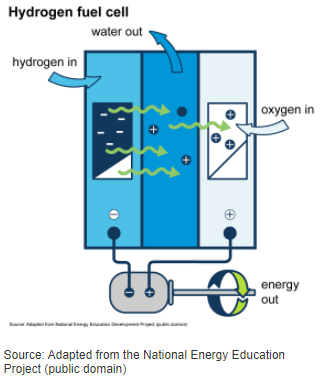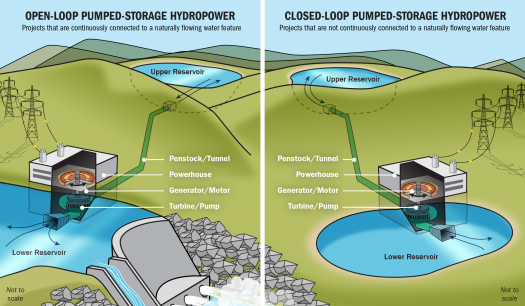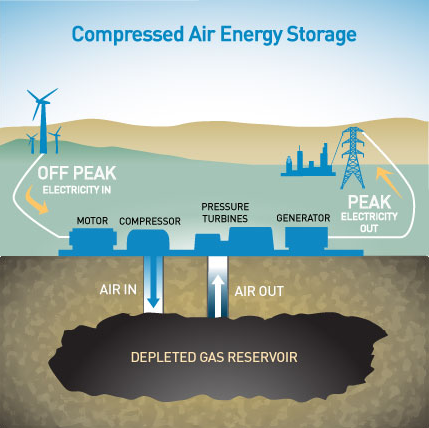There are a variety of energy storage technologies that give us the ability to store energy for use at later times, adding enhanced control, reliability, and resiliency to our electricity grid. As of 2019, the United States had approximately 24 GW of installed energy storage and another 7 GW have been announced or are currently under construction[1] . Almost all the existing storage is pumped-hydropower storage. Storage is particularly important as our grid evolves to incorporate more intermittent renewable and emissions-free energy resources such as wind and solar. These resources are not able to constantly supply our grid with energy; therefore, storage helps balance energy demands when the sun is not shining, or the wind is not blowing.
While the energy storage sector is evolving and new research and development is continuously occurring, there are some technologies we already widely-deploy to help provide added resiliency and reliability to the grid. Common storage technologies include pumped-storage hydropower, batteries, hydrogen, thermal, and other mechanical storage technologies. It is also important to recognize the differences between behind-the-meter storage and utility-scale storage as the technologies, capacities, and development processes associated with them can differ.
Resources:
- The U.S. Department of Energy’s Energy Storage Systems Program Energy Storage Handbook provides a thorough overview of energy storage technology in the United States. It has resource for regulators, policymakers, investors, developers, and the public.
- The U.S. Department of Energy Office of Electricity’s Global Energy Storage Database provides research-grade information on grid-connected energy storage projects and relevant state and federal policies.
Thermal storage traps energy temporarily in the form of heat or cold which allows the energy to be turned into electricity later. An example of this on a utility scale includes solar thermal power plants that use molten salt or other heat-retaining substance to store the sun’s energy, which can be utilized later in steam generating processes.[1]
Mechanical storage systems utilize kinetic or gravitational forces to store inputted energy. One example of a mechanical storage system is the flywheel, a mechanism in which rotational energy is stabilized and maintained through movement of an accelerating wheel that can then store the energy kinetically for future use. A generator is then applied to easily convert the stored energy from mechanical to electrical energy.[2]
Resources:
- The Energy Storage Association provides information on thermal energy storage and mechanical energy storage.
- The U.S. Department of Energy provides a list of fact sheets on various battery storage technologies.
Battery storage can be utilized to store excess energy both at the residential and commercial-scales and at the utility-scale. Energy storage batteries work similarly to regular batteries used in our everyday lives but have much greater storage capacities. Battery storage technology is rapidly growing and evolving because of its scalability and accessibility, and projections show an estimated . Small-scale batteries are being added to approximately one-third of residential solar systems amongst the nation’s leading solar installers.
Energy storage batteries usually have short to mid-range response times of a few seconds to a few hours. There are two categories of batteries used for energy storage, these being solid-state and flow batteries. Solid state batteries utilize different solid chemical compounds for varying grid services while flow batteries utilize chemical compounds that are dissolved in liquid within the battery to create a reaction that produces electricity. Typical solid-state battery types include the highly popular lithium ion as well as the sodium ion, but hybrid batteries and flow or redox flow with a wide range of chemistries are also becoming increasingly popular. Research studies are being conducted on both types of batteries to discover more effective ways to use battery storage.[1]

Resources:
- The Pacific Northwest National Laboratory has extensive information regarding various types of battery technology
- The USAID-NREL Partnership provides an overview of utility and grid-scale battery storage.
- The Energy Storage Association provides extensive information regarding various types of battery technology, and also have a publication specific to behind-the-meter solar.
Electricity can be used to generate hydrogen via electrolysis. The hydrogen can then be stored and eventually re-electrified. Hydrogen can be re-electrified in fuel cells or burned in combined cycle gas power plants. Small amounts of hydrogen can be stored in pressurized vessels, or very large amounts of hydrogen can be stored in constructed underground salt caverns. This method of storage can level excess wind or solar PV production, including seasonal variations. Hydrogen energy storage is growing due to a much higher storage capacity compared to small-scale batteries, large-scale compressed air energy storage (CAES), or pumped hydroelectric.[1]
Hydrogen projects range in size from 1 GWh to 1 TWh, while battery projects typically range from 10 kWh to 10 MWh and pumped hydroelectric storage projects range from 10 MWh to 10 GWh. Like pumped-storage, hydrogen storage relies on using energy when demand is low (or generation is particularly high) to power an electrolysis mechanism and ultimately create hydrogen. This hydrogen has a multitude of uses once it is created – it can be used in stationary fuel cells, for power generation, to provide fuel for fuel cell vehicles, injected as green hydrogen into natural gas pipelines, or stored as compressed gas or other compounds for later use. Unlike batteries that degrade over time, hydrogen can be stored for long periods of time and in large quantities.

Resources:
- The U.S. Department of Energy’s Hydrogen and Fuel Cell Technologies Office has extensive information on the many current and emerging uses of hydrogen in the energy sector.
- The National Renewable Energy Laboratory produced a Hydrogen Energy Storage Publication in February 2015.
Pumped hydroelectric storage facilities, commonly referred to as pumped-hydro or pumped-storage, store energy by utilizing excess electricity when energy demand is low to pump water from a lower to a higher reservoir to be released through turbines when energy demand is high; providing storage and added reliability or ancillary services. Pumped hydroelectric storage is a form of mechanical storage. Both pumped hydroelectric storage and compressed air systems can provide long term storage, more than a few hours.[1]
Pumped hydroelectric storage can require very specific geographic terrain when compared to other types of storage. Much of the pumped hydroelectric storage infrastructure across the nation was initiated during the 1970s. Currently about 90% of the world’s energy storage and 95% of United States’ energy storage is pumped-hydro based.
Pumped hydroelectric storage projects can be open-loop or closed-loop. Open-loop projects are connected to a naturally existing body of water, and closed-loop projects are connected to a man-made reservoir. There are currently 43 pumped-storage hydropower projects with a combined generation capacity of approximately 22 GW in the United States, but projections show that number is likely to grow as storage demands rise in the coming years. While there have been proposed pumped-storage projects in Idaho, there are currently no operational projects.

Resources:
- The U.S. Department of Energy’s Water Power Technologies Office has extensive research, funding information, and modeling on pumped hydroelectric storage.
- Through the Hydropower Vision, the U.S. Department of Energy’s Wind and Water Power Technologies Office has led a first-of-its-kind comprehensive analysis to evaluate future pathways for low-carbon, renewable hydropower (hydropower generation and pumped storage) in the United States, focused on continued technical evolution, increased energy market value, and environmental sustainability.
- The National Hydropower Association’s Pumped Storage Development Council published a whitepaper that goes in depth on the potential for new pumped-storage projects, and challenges in the sector.
- The U.S. Energy Information Administration provides information on U.S. pumped storage electricity generators built in the 1970s.
Compressed air energy storage (CAES) is also a form of mechanical storage. CAES plants are very similar to pumped-hydro power plants, but instead of pumping water from one reservoir to another, in a compressed air plant, air or another gas is compressed and stored in an underground cavern or pressurized container. When electricity demand increases, the pressurized air is heated and expanded to move a turbine and produce power.
Since the 1870’s, CAES systems have been deployed to provide effective, on-demand energy for cities and industries. While many smaller applications exist, the first utility-scale CAES system was put in place in the 1970’s with over 290 MW nameplate capacity[1]. CAES offers the potential for small-scale, on-site energy storage solutions as well as larger installations that can provide immense energy reserves for the grid.

Resources:
- The Energy Storage Association provides extensive information regarding CAES.
- The Bonneville Power Administration teamed with the Pacific Northwest National Laboratory and a full complement of industrial and utility partners to evaluate and provide a report on the technical and economic feasibility of developing CAES.
- The U.S. Department of Energy’s Office of Energy Efficiency and Renewable Energy provides an overview of compressed air systems.
Behind-the-meter (BTM) energy storage allows for storage energy to directly benefit a home or business without going through an electric meter or interacting with the grid. Typically, this kind of storage utilizes a battery to store excess renewable generation created on-site. This can add increased resilience and demand-side control for customers who live in areas that are prone to power outages, or who would rather keep the excess energy they generate instead of selling it back to the grid. Typically, a hybrid renewable plus battery system is utilized for BTM energy storage.

Resources:
- The Energy Storage Association provides a publication specific to behind-the-meter solar.
- The National Renewable Energy Laboratory produced a publication in March 2020 titled An Overview of Behind-The-Meter Solar-Plus-Storage Regulatory Design.
- The International Renewable Energy Agency produced a publication in 2019 titled Behind-The-Meter Batteries: Innovation Landscape Brief.
 Official Government Website
Official Government Website